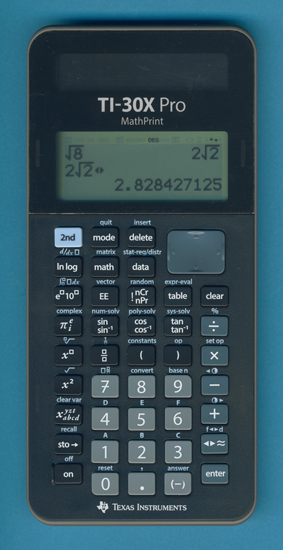
DATAMATH CALCULATOR MUSEUM
 |
DATAMATH CALCULATOR MUSEUM |
Texas Instruments TI-30X Pro MathPrint™
| Date of introduction: | February 20, 2018 Available: Oct. 2018 |
Display technology: | LCD dot matrix |
| New price: | Display size: | 4 * 16 characters (5 * 19 for menus) |
|
| Size: | 6.7" x 3.2" x 0.45" 170 x 81 x 12 mm³ |
||
| Weight: | 3.7 ounces, 106 grams | Serial No: | |
| Batteries: | Solar cells + 2*CR2032 | Date of manufacture: | mth 09 year 2018 |
| AC-Adapter: | Origin of manufacture: | Philippines (L) | |
| Precision: | 13 | Integrated circuits: | |
| Logic: | EOS | ||
| Memories: | 8 | ||
| Program steps: | Courtesy of: | Joerg Woerner | |
| Download leaflet: |
|
Download manual: | |

![]()
 Texas
Instruments announced on February 20, 2018 at the didacta 2018,
an Education Trade Show in Germany, with the TI-30X
Plus MathPrint and TI-30X Pro MathPrint the stylish successors of both the
TI-30X Plus MultiView and TI-30X Pro MultiView.
Texas
Instruments announced on February 20, 2018 at the didacta 2018,
an Education Trade Show in Germany, with the TI-30X
Plus MathPrint and TI-30X Pro MathPrint the stylish successors of both the
TI-30X Plus MultiView and TI-30X Pro MultiView.
It is rather unusual to discontinue and replace a scientific calculator within just three years after its introduction but in this case there was a serious reason behind the unexpected move from Texas Instruments. In July 2017 the Ministry of Education, Youth and Sport of Baden Wurttemberg, Germany informed all schools in the State that it is known since March 2017 to "hack" with a few keystrokes the TI-30X Plus MultiView and upgrade it to the original TI-30X Pro MultiView. One has to understand that the TI-30X Plus MultiView was removing some features from the original TI-30X Pro MultiView:
|
• Numeric derivative • Numeric integral • Numeric equation solver • Polynomial solver |
The reason for this down-grading are pretty obvious - two States in Germany (Bavaria and Baden Wurttemberg) don't allow these features in their High Schools exams anymore. Texas Instruments consequently informed in Summer 2017 to release an updated version of the TI-30X Plus MultiView for Back-to-School 2018/2019.
Comparing the original TI-30X Pro MultiView with its successor reveals three major differences:
|
• Modern design matching the
TI-84 Plus CE series • LC Display with higher resolution • Reset function shows Operating System version |
![]() The
new LC Display of the TI-30X Pro MathPrint sports a resolution of 64 * 192 addressable pixels compared to 31 * 96
pixels of its predecessor allowing a much nicer font for both numbers and
characters. Interesting trivia: Texas Instruments' first graphing calculator,
the TI-81 introduced in 1990,
featured only 64 * 96 pixels.
The
new LC Display of the TI-30X Pro MathPrint sports a resolution of 64 * 192 addressable pixels compared to 31 * 96
pixels of its predecessor allowing a much nicer font for both numbers and
characters. Interesting trivia: Texas Instruments' first graphing calculator,
the TI-81 introduced in 1990,
featured only 64 * 96 pixels.

 The "MathPrint" mode displays equations as they would be
printed in a text book while the "Classic" mode emulates the
TI-30X IIS calculators.
The "MathPrint" mode displays equations as they would be
printed in a text book while the "Classic" mode emulates the
TI-30X IIS calculators.
 Texas
Instruments introduced with the TI-30X Pro MathPrint a new feature for a Scientific
calculator - obviously initiated by the "hack" of the TI-30X Plus MultiView:
Pressing the [reset] button displays immediately the current Operating System
version of the calculator.
Texas
Instruments introduced with the TI-30X Pro MathPrint a new feature for a Scientific
calculator - obviously initiated by the "hack" of the TI-30X Plus MultiView:
Pressing the [reset] button displays immediately the current Operating System
version of the calculator.

 Dismantling
this TI-30X Pro MathPrint manufactured in September 2018 reveals a pretty common
construction with two printed circuit boards (PCBs). The main PCB hides the
single-chip calculating circuit under a small protection blob of black epoxy and
drives the graphing display with a heat sealed fine-pitch connector. The
keyboard makes use of a much simpler second PCB and a heat sealed connector,
too.
Dismantling
this TI-30X Pro MathPrint manufactured in September 2018 reveals a pretty common
construction with two printed circuit boards (PCBs). The main PCB hides the
single-chip calculating circuit under a small protection blob of black epoxy and
drives the graphing display with a heat sealed fine-pitch connector. The
keyboard makes use of a much simpler second PCB and a heat sealed connector,
too.
 The prominent SR-36 designation on the main PCB proves that this calculator was manufactured by Kinpo Electronics,
Inc., a famous company located in Taiwan and doing calculator production for
well established companies like Texas Instruments, Hewlett Packard, Casio, Canon
and Citizen.
The prominent SR-36 designation on the main PCB proves that this calculator was manufactured by Kinpo Electronics,
Inc., a famous company located in Taiwan and doing calculator production for
well established companies like Texas Instruments, Hewlett Packard, Casio, Canon
and Citizen.
 The featured calculator was purchased in
December 2018 in Germany
with an Online Shop
and was delivered in a simple cardboard box, most likely bulk packaging for
schools.
The featured calculator was purchased in
December 2018 in Germany
with an Online Shop
and was delivered in a simple cardboard box, most likely bulk packaging for
schools.
As of December 2018 the TI-30X Pro MathPrint
was featured on TI's website for the following countries: Austria, Denmark, Finland, Germany, Italy, Norway, Sweden
and Switzerland.
The TI-30X Plus MathPrint was featured only for Austria,
Germany and Switzerland. Don't miss the
TI-30X Prio MathPrint introduced in 2023.
If you have additions to the above article please email: joerg@datamath.org.
© Joerg Woerner, June 25, 2019. No reprints without written permission.